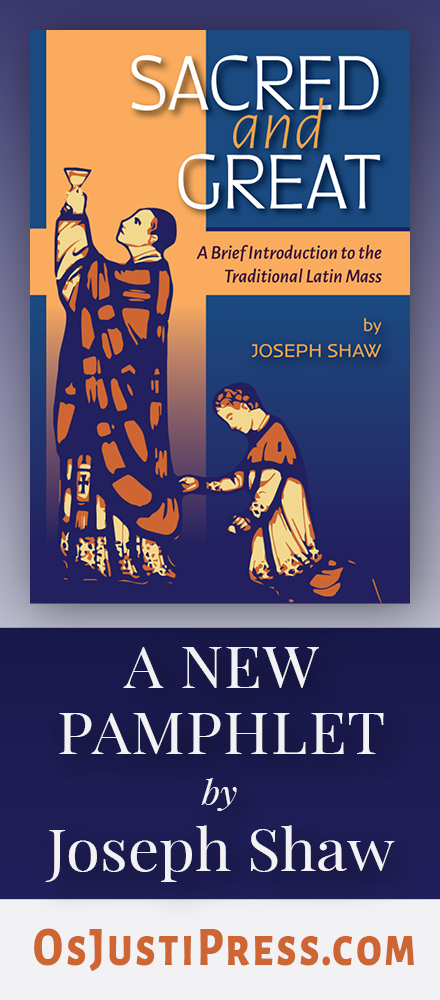Years ago, I was discussing music with a parishioner who attended the "contemporary" music Mass, and (no surprise) I mentioned the glories of chant (why must I do that?). Her response was honest but tough to take: "I find chant so depressing. Christianity is about joy."
Of course my first reaction is to bristle up like a porcupine but there is no sense in taking issue with someone's subjective impressions. Chant either helps her pray or it doesn't, and if she finds that that it depresses her, am I suppose to argue her out of that position?
What that conversation did do, however, was bring about a certain alertness to the requirement that singers do their best to convey joy within the chant tradition when it is appropriate to do so—not in the same earth-bound, yippee way that contemporary pop music does but in a manner that points to transcendent joy, infused with the mysterious awe that comes from reflection on the final victory over death.
And thus this weekend's communio: Laetabimur
We begin with rejoicing, not the usual intonation of a few notes but one that is long and melismatic. Economy is given up in favor of extended exuberance. The schola joins by picking the phrase and taking it to its highest point in the middle of the word salvation. Immediately, the listener knows the theme, even if the text were not the there.
The name of the Lord follows with two successive affirmations of the Trinity. We end with this wonderful phrase on "magnificabimur" in which the last syllable seems to wait and wait until the last possible moment. The "mur" here recalls the initial "mur" in laetabimur. Joy and pride in our God!
Different chants require subtle changes in tempo but it strikes me that this one should be sung on the faster end of the metronome. Timing it out with this online metronome, I might suggest about 184 beats per minute for the punctum—which is quite fast, faster than the adult heart pulses during strenuous exercise but on the upper end of a child's pulse after bounding around the yard in sheer love of life. The same sense is conveyed here in a contained and upward looking way. This is the song of salvation. Learn it for Sunday and you will carry it in your heart all week.
Here is a version you can print and learn, with Psalms.
Saturday, October 28, 2006
Rejoice in the Chant
Jeffrey TuckerMore recent articles:
Should Communion Sometimes Be Eliminated to Avoid Sacrilege?Peter Kwasniewski
In a post at his Substack entitled “Nobody is talking about this in the Catholic world,” Patrick Giroux has the courage and good sense to raise the issue of the indiscriminate reception of the Lord at weddings and funerals where many attendees are not Catholics, or, if Catholics, not practicing, not in accord with Church teaching, or not in a state...
Update on the Palestrina500 Festival in Grand RapidsPeter Kwasniewski
On Friday, February 14th, the feast of Saint Valentine, Sacred Heart of Jesus Parish in Grand Rapids, MI welcomed Gesualdo Six from London to sing a choral meditation and Mass for the parish's yearlong Palestrina500 festival.The choral meditation consisted of:Palestrina: Litaniae de Beata Virgine Maria a6Antoine Brumel: Sub tuum praesidiumJosquin d...
Catholic Education Foundation Seminar 2025: The Role of the Priest in Today’s Catholic SchoolDavid Clayton
July 16-18, at the Athenaeum of Ohio (the seminary of the Archdiocese of Cincinnati).Fr Peter Stravinskas of the Catholic Education Foundation is once again offering this excellent three-day seminar, intended primarily for bishops, priests, and seminarians. It is entitled The Role of the Priest in Today’s Catholic School.For further information: c...
Pope Francis RIPGregory DiPippo
Deus, qui inter summos sacerdótes fámulum tuum Franciscum ineffábili tua dispositióne connumerári voluisti: praesta, quáesumus; ut, qui Unigéniti Filii tui vices in terris gerébat, sanctórum tuórum Pontíficum consortio perpétuo aggregétur. Per eundem Christum, Dóminum nostrum. Amen.Courtesy of Shawn Tribe and Liturgical Arts JournalGod, Who in Thy ...
The Byzantine Paschal HourGregory DiPippo
In the Roman Rite, the minor Hours of Easter and its octave are celebrated according to a very simple and archaic form, which consists solely of the psalmody, the antiphon Haec dies, and the prayer, with the usual introduction and conclusion. (Haec dies is labeled as an “antiphon” in the Breviary, but it is identical to the first part of the gradu...
Easter Sunday 2025Gregory DiPippo
An icon of the Harrowing of Hell made in Constantinople in the late 14th century.Let all partake of the feast of faith. Let all receive the riches of goodness. Let no one lament their poverty, for the universal kingdom has been revealed. Let no one mourn their transgressions, for pardon has dawned from the grave. Let no one fear death, for the Savi...
The Twentieth Anniversary of Pope Benedict XVI’s ElectionGregory DiPippo
On this Holy Saturday, we also mark the 20th anniversary of the election of His Holiness Pope Benedict XVI. Let us remember with gratitude the gift of his papacy, his graciousness and good humor, his many wise and well-considered writings, his paternal love especially for priests and religious, but of course above all, his restoration to the Church...
Holy Saturday 2025Gregory DiPippo
The Harrowing of Hell, by Duccio di Buoninsenga, 1308-11 R. Recessit pastor noster, fons aquae vivae, ad cujus transitum sol obscuratus est; * nam et ille captus est, qui captivum tenebat primum hominem: hodie portas mortis et seras pariter Salvator noster disrupit. V. Destruxit quidem claustra inferni, et subvertit potentias diaboli. Nam et ill...
Good Friday 2025Gregory DiPippo
The table of the Epitaphios at the end of Vespers today at St Anthony the Abbot, the Russian Greek-Catholic church in Rome.For how shall we be able to know, I and thy people, that we have found grace in thy sight, unless thou walk with us, that we may be glorified by all people that dwell upon the earth? And the Lord said to Moses: This word also, ...
Desacralizing LentMichael P. Foley
Christ in the Desert, 1898, by Breton RivièreI have been enjoying Peter Kwasniewski’s new book Close the Workshop, which argues that the old rite did not need to be fixed and that the new rite cannot be fixed. To support his argument, Kwasniewski begins with an analysis of the Second Vatican Council’s Constitution on the Liturgy, Sacrosanctum Conci...




















